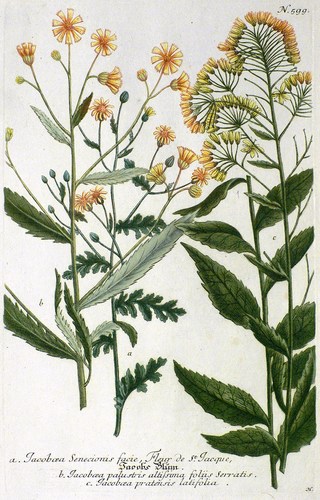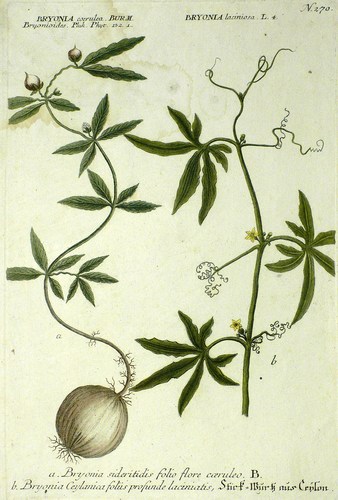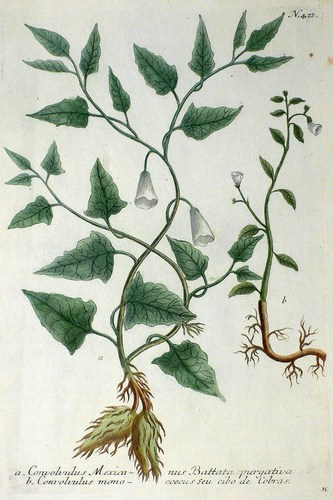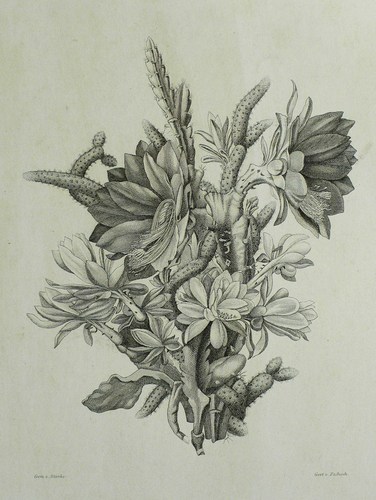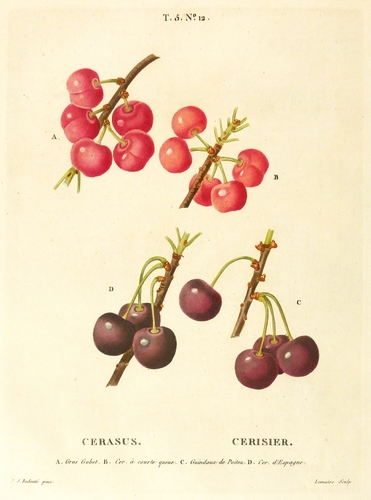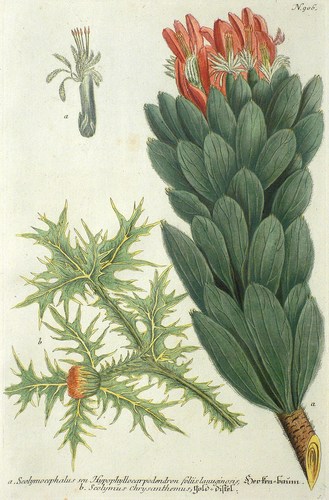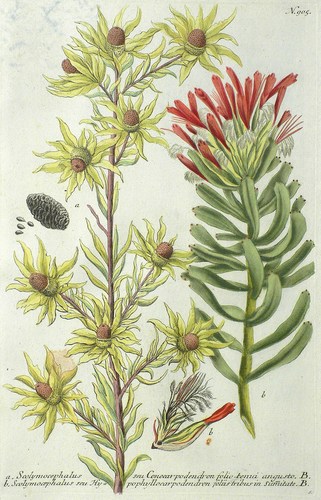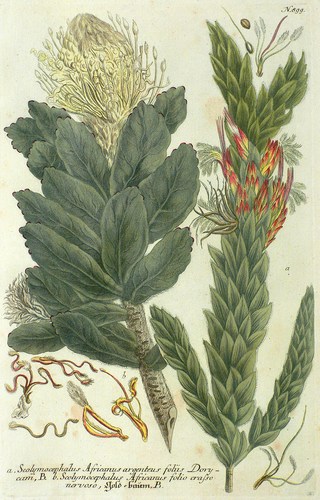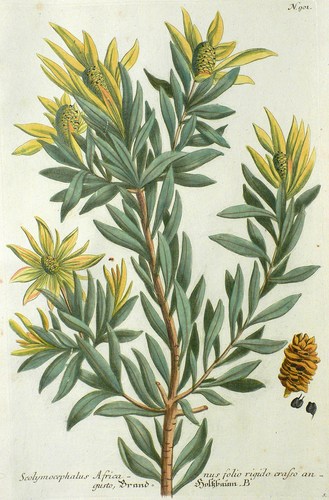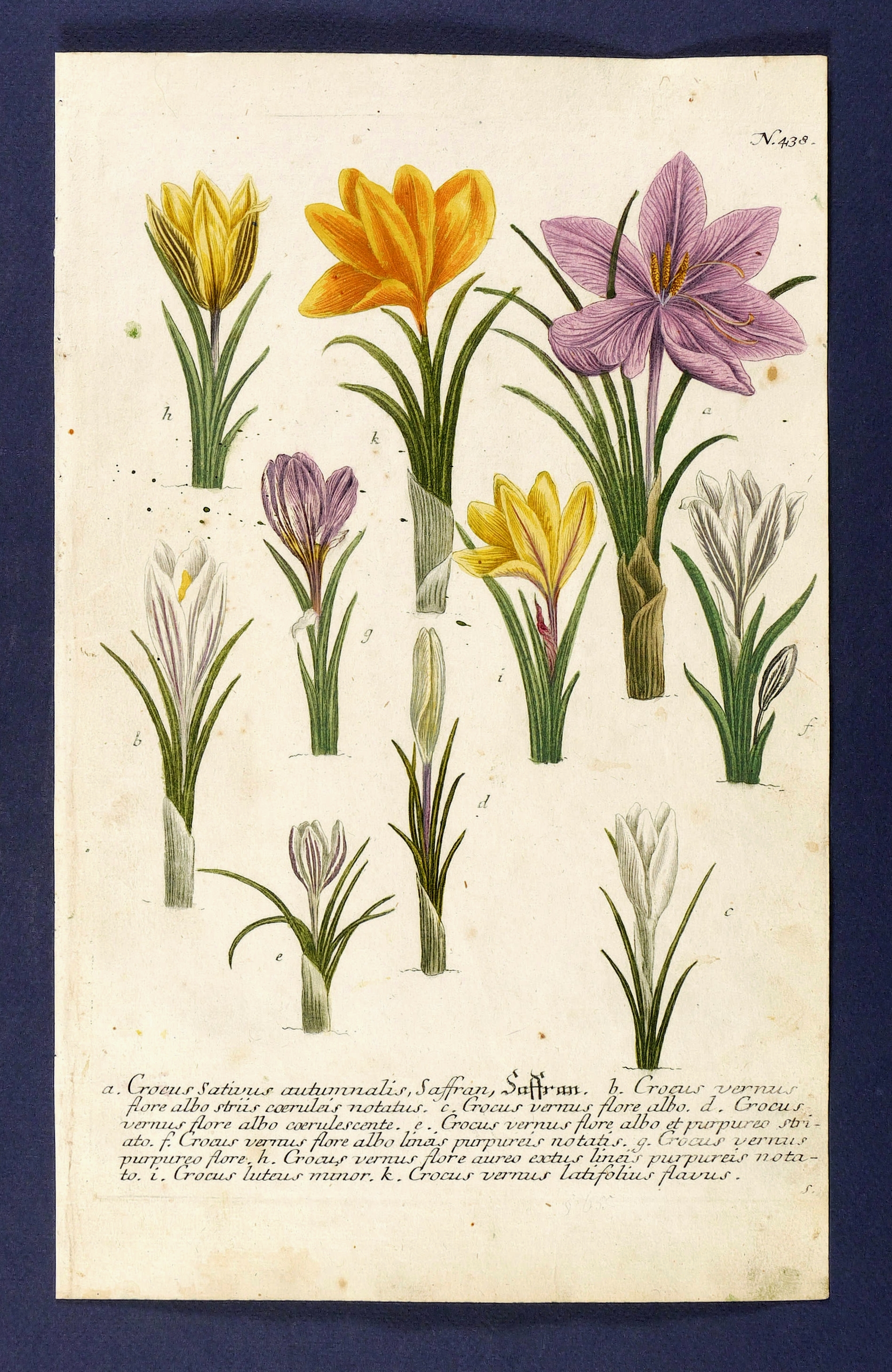

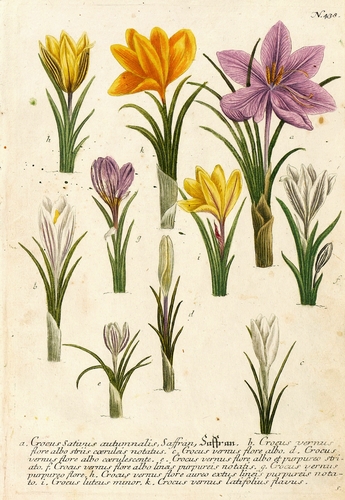
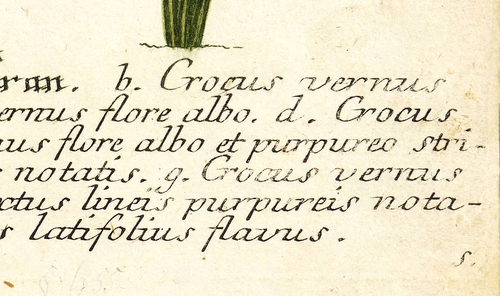
Krokusse. – Safran & Frühlings-Krokus. – Weinmann. – „Crocus Sativus. Saffran. Crocus vernus”.
1739. Kupferstich / Mezzotinto, alt koloriert. – Von Bartholomäus Seutter. – 32,1 x 21,7 cm (Darstellung / Platte), 37 x 23 cm (Blatt).
0,00 € Deutschland 8,00 € Europa 26,00 € weltweit
Aus: Johann Wilhelm Weinmann, Phytanthoza-Iconographia Oder Eigentliche Vorstellung Etlicher Tausend, So wohl Einheimisch- als Ausländischer, aus allen vier Welt-Theilen, in Verlauf vieler Jahre (...) gesammelter Pflantzen, Bäume, Stauden, Kräuter, Blumen, Früchten und Schwämme (Regensburg: Hieronymus Lentz 1737-1745), Bd. 2 (1739). – In der Platte rechts unten Signatur, rechts oben Tafel-Nr. "438", unten mittig ausführliche Inschrift: "a. Crocus sativus autumnalis, Saffran, Saffran. b. Crocus vernus flore albo striis coeruleis notatus. c. Crocus vernus flore albo. d. Crocus vernus flore albo coerulescente. e. Crocus vernus flore albo et purpureo striato. f. Crocus vernus flore albo lineis purpureis notatis. g. Crocus vernus purpureo flore. h. Crocus vernus flore aureo extus lineis purpureis notato. i. Crocus luteus minor. k. Crocus vernus latifolius flavus." – Bei der Herstellung der Tafeln arbeiteten die Augsburger Künstler Bartholomäus Seutter, Johann Jakob Haid und Johann Elias Ridinger zusammen. Die Kupfer wurden in einer für die Zeit revolutionären Weise farbig gedruckt und sodann partiell von Hand koloriert. Dabei fand der von Seutter weiterentwickelte Mezzotinto-Farbdruck des Niederländers Johannes Teyler Anwendung. – Das kräftige Büttenpapier etwas stockleckig, im Randbereich angeschmutzt. Kolorit kontrastreich erhalten. Dem Alter entsprechend noch guter Zustand.
Bartholomäus Seutter (1678 Augsburg - 1754 Augsburg). Auch Bartholomäus Seuter. Deutscher Goldschmied, Emailleur, Porzellan- und Fayencemaler, Kupferstecher, Schabkünstler und Verleger. Bemalte u.a. die Keramiken seines Bruders, des Augsburger Goldschmieds und Feuermalers Abraham Seuter (1699–1747). Übernahm und verbesserte das Mezzotinto-Farbdruckverfahren des Niederländers Johannes Teyler. Lieferte in Zusamenarbeit mit Johann Jakob Haid und Johann Elias Ridinger die Platten zu Johann Wilhelm Weinmanns Phytanthoza-Iconographia (1737-45).
Historische PflanzendarstellungGewürzpflanzenSchwertliliengewächse (Iridaceae)FrühblüherBlume / Blumen (Motiv)Frühling / Frühjahr (Jahreszeit)Blüte / Blüten (Motiv)Safran (Crocus sativus)ZwiebelgewächseKrokus / Krokusse (Crocus)Frühlingskrokus / Frühlingskrokusse (Crocus vernus)
1739. Kupferstich / Mezzotinto, alt koloriert. – Von Bartholomäus Seutter. – 32,1 x 21,7 cm (Darstellung / Platte), 37 x 23 cm (Blatt).
240,00 €
inkl. MwSt. zzgl. Versandkosten
inkl. MwSt. zzgl. Versandkosten
0,00 € Deutschland 8,00 € Europa 26,00 € weltweit
Aus: Johann Wilhelm Weinmann, Phytanthoza-Iconographia Oder Eigentliche Vorstellung Etlicher Tausend, So wohl Einheimisch- als Ausländischer, aus allen vier Welt-Theilen, in Verlauf vieler Jahre (...) gesammelter Pflantzen, Bäume, Stauden, Kräuter, Blumen, Früchten und Schwämme (Regensburg: Hieronymus Lentz 1737-1745), Bd. 2 (1739). – In der Platte rechts unten Signatur, rechts oben Tafel-Nr. "438", unten mittig ausführliche Inschrift: "a. Crocus sativus autumnalis, Saffran, Saffran. b. Crocus vernus flore albo striis coeruleis notatus. c. Crocus vernus flore albo. d. Crocus vernus flore albo coerulescente. e. Crocus vernus flore albo et purpureo striato. f. Crocus vernus flore albo lineis purpureis notatis. g. Crocus vernus purpureo flore. h. Crocus vernus flore aureo extus lineis purpureis notato. i. Crocus luteus minor. k. Crocus vernus latifolius flavus." – Bei der Herstellung der Tafeln arbeiteten die Augsburger Künstler Bartholomäus Seutter, Johann Jakob Haid und Johann Elias Ridinger zusammen. Die Kupfer wurden in einer für die Zeit revolutionären Weise farbig gedruckt und sodann partiell von Hand koloriert. Dabei fand der von Seutter weiterentwickelte Mezzotinto-Farbdruck des Niederländers Johannes Teyler Anwendung. – Das kräftige Büttenpapier etwas stockleckig, im Randbereich angeschmutzt. Kolorit kontrastreich erhalten. Dem Alter entsprechend noch guter Zustand.
Bartholomäus Seutter (1678 Augsburg - 1754 Augsburg). Auch Bartholomäus Seuter. Deutscher Goldschmied, Emailleur, Porzellan- und Fayencemaler, Kupferstecher, Schabkünstler und Verleger. Bemalte u.a. die Keramiken seines Bruders, des Augsburger Goldschmieds und Feuermalers Abraham Seuter (1699–1747). Übernahm und verbesserte das Mezzotinto-Farbdruckverfahren des Niederländers Johannes Teyler. Lieferte in Zusamenarbeit mit Johann Jakob Haid und Johann Elias Ridinger die Platten zu Johann Wilhelm Weinmanns Phytanthoza-Iconographia (1737-45).
Historische PflanzendarstellungGewürzpflanzenSchwertliliengewächse (Iridaceae)FrühblüherBlume / Blumen (Motiv)Frühling / Frühjahr (Jahreszeit)Blüte / Blüten (Motiv)Safran (Crocus sativus)ZwiebelgewächseKrokus / Krokusse (Crocus)Frühlingskrokus / Frühlingskrokusse (Crocus vernus)
Folgende Werke könnten Ihnen auch gefallen:
Heilpflanzen & Giftpflanzen. – Greiskraut / Kreuzkraut. - Senecio. – Weinmann. – „Jacobs Blum”.
1739. Kupferstich / Mezzotinto, alt koloriert. – Von Johann Jakob Haid. – 32,5 x 20,6 cm (-), 38,5 x 24,5 cm (Blatt),
1739. Kupferstich / Mezzotinto, alt koloriert. – Von Johann Jakob Haid. – 32,5 x 20,6 cm (-), 38,5 x 24,5 cm (Blatt),
120,00 €
Zaunrüben. – Bryonia. – Weinmann. – „Stick-Wurtz aus Ceylon”.
1739. Kupferstich / Mezzotinto, alt koloriert. – 32,5 x 21,4 cm (-), 38,5 x 25 cm (Blatt),
1739. Kupferstich / Mezzotinto, alt koloriert. – 32,5 x 21,4 cm (-), 38,5 x 25 cm (Blatt),
80,00 €
Gemüse. – Süßkartoffel. - Batate. – Weinmann. – „Convolvulus Mexicanus Battata”.
1739. Kupferstich / Mezzotinto, alt koloriert. – Von Johann Jakob Haid. – 32,0 x 21,2 cm (-), 38,5 x 23,5 cm (Blatt),
1739. Kupferstich / Mezzotinto, alt koloriert. – Von Johann Jakob Haid. – 32,0 x 21,2 cm (-), 38,5 x 23,5 cm (Blatt),
180,00 €
Kakteen. – Blüten verschiedener Kakteen. – nach Johann Friedrich Starke „Cactus Blüthen”.
1829. Kupferstich / Linienstich. – Von Christian Gottfried Zschoch, nach Johann Friedrich Starke. – 29,0 x 23,9 cm (Darstellung / Platte), 46 x 30 cm (Blatt),
1829. Kupferstich / Linienstich. – Von Christian Gottfried Zschoch, nach Johann Friedrich Starke. – 29,0 x 23,9 cm (Darstellung / Platte), 46 x 30 cm (Blatt),
60,00 €
Obst. – Kirschen. – nach Pierre-Joseph Redouté „Cerasus. Cerisier”.
1812. Farbkupferstich / Punktstich. – Von J. Lemaire, nach Pierre-Joseph Redouté. – 30,8 x 22,8 cm (Darstellung / Platte), 38,5 x 29,5 cm (Blatt),
1812. Farbkupferstich / Punktstich. – Von J. Lemaire, nach Pierre-Joseph Redouté. – 30,8 x 22,8 cm (Darstellung / Platte), 38,5 x 29,5 cm (Blatt),
160,00 €
Silberbaumgewächse (Proteen). – Rote Pagoda (Mimetes cucullatus) & Golddistel. – Weinmann. – „Herken-baum. Gold-distel”.
1742. Kupferstich / Mezzotinto, alt koloriert. – Von Bartholomäus Seutter. – 33,2 x 21,3 cm (-), 39 x 24,5 cm (Blatt),
1742. Kupferstich / Mezzotinto, alt koloriert. – Von Bartholomäus Seutter. – 33,2 x 21,3 cm (-), 39 x 24,5 cm (Blatt),
140,00 €
Silberbaumgewächse / Protea. – Weinmann. – „Scolymocephalus seu Conocarpodendron. Scolymocephalus seu Hypophyllocarpodendron”.
1742. Kupferstich / Mezzotinto, alt koloriert. – Von Bartholomäus Seutter. – 33,2 x 21,1 cm (-), 39 x 24,5 cm (Blatt),
1742. Kupferstich / Mezzotinto, alt koloriert. – Von Bartholomäus Seutter. – 33,2 x 21,1 cm (-), 39 x 24,5 cm (Blatt),
130,00 €
Silberbaumgewächse (Proteaceae). – Mimentes hirtus Salisb. – Weinmann. – „Scolymocephalus Africanus. Gold-baum”.
1745. Kupferstich / Mezzotinto, alt koloriert. – Von Johann Jakob Haid. – 32,8 x 20,7 cm (-), 38,5 x 25 cm (Blatt),
1745. Kupferstich / Mezzotinto, alt koloriert. – Von Johann Jakob Haid. – 32,8 x 20,7 cm (-), 38,5 x 25 cm (Blatt),
120,00 €











